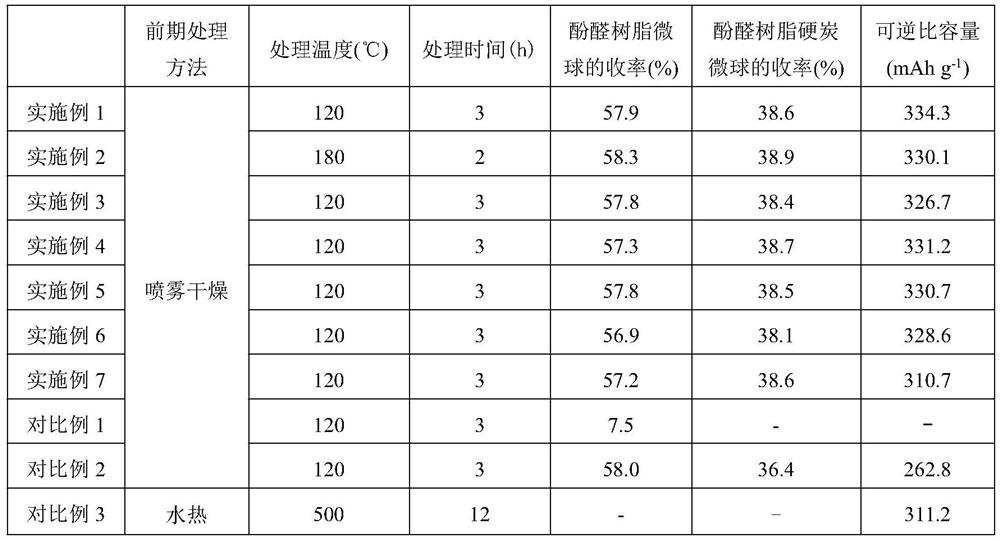Preparation method of phenolic resin-based hard carbon microsphere material
A technology of phenolic resin and microspheres, which is applied in the field of electrochemistry, can solve the problems of high energy consumption, low output and yield, and long production cycle, and achieve the effects of simple operation, high yield, and low energy consumption
- Summary
- Abstract
- Description
- Claims
- Application Information
AI Technical Summary
Problems solved by technology
Method used
Image
Examples
Embodiment 1
[0029] Pour 20g of phenol, 58g of water, 8.4g of polyvinyl alcohol with a molecular weight of 77000, and 32wt.% sodium hydroxide solution (NaOH:phenol=1:5, mol ratio) into a three-necked flask, and stir at 92°C for 15min Raise the temperature to 95° C., add 20 g of formaldehyde and stir for 1 h, then add 5 g of formaldehyde and continue stirring for 100 min to obtain a liquid resole resin. The obtained phenolic resole resin was placed in a large beaker, a certain amount of distilled water was added thereto and stirred at room temperature for 2 hours to form a cloudy solution of phenolic resin with a solid content of 3 wt%.
[0030] The cloudy phenolic resin solution was spray-dried under stirring to obtain powdered phenolic resin microspheres. The inlet temperature was set at 120°C and the material flow rate was set at 400mL / h.
[0031] The powdered phenolic resin microspheres were placed in an oven at a constant temperature of 150° C. for 20 h for pre-oxidation to obtain pre-...
Embodiment 2
[0034]Pour 20g of phenol, 58g of water, 8.4g of polyvinyl alcohol with a molecular weight of 77000, and 32wt.% sodium hydroxide solution (NaOH:phenol=1:5, mol ratio) into a three-necked flask, and stir at 92°C for 15min Raise the temperature to 95° C., add 20 g of formaldehyde and stir for 1 h, then add 5 g of formaldehyde and continue stirring for 100 min to obtain a liquid resole resin. The obtained phenolic resole resin was placed in a large beaker, a certain amount of distilled water was added thereto and stirred at room temperature for 2 hours to form a cloudy solution of phenolic resin with a solid content of 3 wt%.
[0035] The cloudy phenolic resin solution was spray-dried under stirring to obtain powdered phenolic resin microspheres. The inlet temperature was set at 180°C and the material flow rate was set at 600mL / h.
[0036] The powdered phenolic resin microspheres were placed in an oven at a constant temperature of 150° C. for 20 h for pre-oxidation to obtain pre-o...
Embodiment 3
[0039] Pour 40g of phenol, 116g of water, 16.8g of polyvinyl alcohol with a molecular weight of 77,000, and 32wt.% sodium hydroxide solution (NaOH:phenol=1:5, mol ratio) into a three-necked flask, and stir at 92°C for 15min Raise the temperature to 95° C., add 40 g of formaldehyde and stir for 1 h, then add 10 g of formaldehyde and continue stirring for 100 min to obtain a liquid resol resin. The obtained phenolic resole resin was placed in a large beaker, a certain amount of distilled water was added thereto and stirred at room temperature for 2 hours to form a cloudy solution of phenolic resin with a solid content of 3 wt%.
[0040] The cloudy phenolic resin solution was spray-dried under stirring to obtain powdered phenolic resin microspheres. The inlet temperature was set at 120°C and the material flow rate was set at 400mL / h.
[0041] The powdered phenolic resin microspheres were placed in an oven at a constant temperature of 150° C. for 20 h for pre-oxidation to obtain p...
PUM
 Login to view more
Login to view more Abstract
Description
Claims
Application Information
 Login to view more
Login to view more - R&D Engineer
- R&D Manager
- IP Professional
- Industry Leading Data Capabilities
- Powerful AI technology
- Patent DNA Extraction
Browse by: Latest US Patents, China's latest patents, Technical Efficacy Thesaurus, Application Domain, Technology Topic.
© 2024 PatSnap. All rights reserved.Legal|Privacy policy|Modern Slavery Act Transparency Statement|Sitemap

